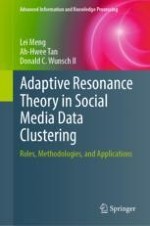Discovering
social
communities
of web users through
clustering analysis of heterogeneous
link
associations has drawn much attention. However, existing approaches
typically require the number of clusters
a priori
, do not address the weighting
problem for fusing heterogeneous types of links, and have a heavy computational cost. This chapter studies the commonly used social links
of users and explores the feasibility
of the proposed heterogeneous data
co-clustering
algorithm
GHF-ART, as introduced in Sect.
3.6, for discovering user communities
in social
networks
. Contrary to the existing algorithms
proposed for this task, GHF-ART performs real-time matching
of patterns
and one-pass learning
, which guarantees its low computational cost
. With a vigilance
parameter
to restrain the intra-cluster
similarity
, GHF-ART
does not need the number of clusters a priori. To achieve a better fusion
of multiple types of links, GHF-ART employs a weighting algorithm, called
robustness measure (RM)
, to incrementally assess the importance of all the feature
channels for the representation
of data objects of the same class. Extensive experiments have been conducted on two social network datasets
to analyze the performance
of GHF-ART. The promising results compare GHF-ART with existing methods and demonstrate the effectiveness and efficiency of GHF-ART. The content of this chapter is summarized and extended from [
11] (Copyright ©2014 Society for Industrial and Applied Mathematics. Reprinted with permission. All rights reserved).
